São Miguel is the largest and most versatile island in the Portuguese archipelago of the Azores, both in terms of size and population. There are a lot of unique things to see and do on the island, which is also why it can be recommended as the first destination from where to start exploring the best kept secret of Europe – the enchanting Azores.
The most amazing experiences on São Miguel include admiring the views over the blue and green crater lakes, relaxing in the natural hot springs and watching wild whales and dolphins on the Atlantic waters. There are many natural wonders to be experienced, from waterfalls hidden along lush hiking trails to standing on a steaming crater of an active volcano, as well as spending a beach day on an islet of volcanic origin, whose perfectly round crater forms a natural swimming pool. São Miguel is truly a nature lover’s dream destination and the black sand beaches, mystical forests, green mountains and exotic pineapple and tea plantations of the island leave no one cold.
Of all the Azorean islands, São Miguel is the one receiving by far the most tourists annually, which is also why the island has the best selection of hotels, restaurants and different services available. It’s easy to spend one or two weeks on São Miguel, but if time is scarce, it is possible to see the island’s main points of interest in approximately four days.
São Miguel features accommodation in the capital, coastal villages and green valleys
São Miguel is a 64 kilometers long island, whose capital Ponta Delgada is located approximately in the central part of the southern coast. Ponta Delgada is a good choice for the home base of the holiday, especially if planning to stay in an urban environment and in one place for the whole trip. The lodging selection goes from stylish and modern five star luxury hotels to sympathetic guest houses, affordable hostels and cozy holiday apartments. There are also many resort-style hotels with their large pool areas in Ponta Delgada as well as elsewhere on the island.
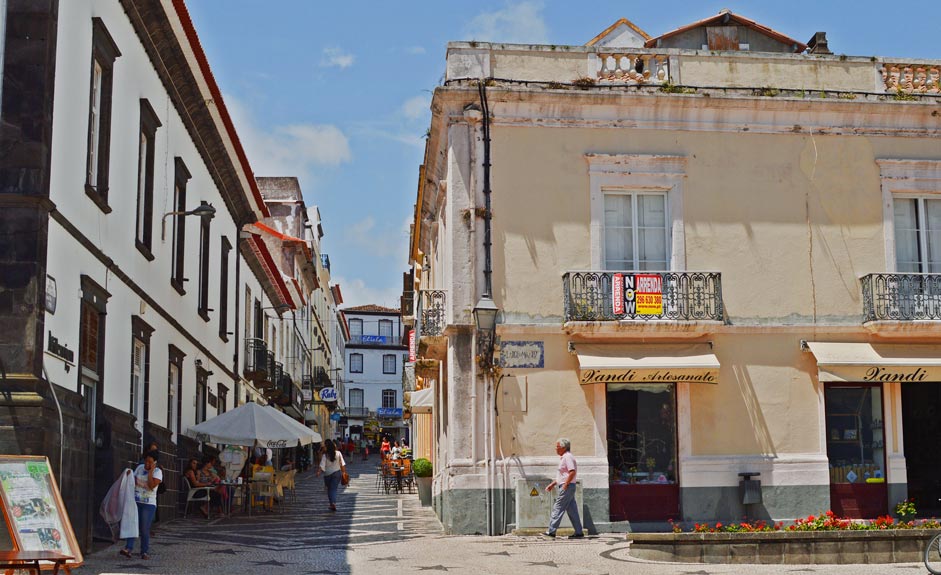
There are some 140 000 inhabitants living on São Miguel, 69 000 of which live in the Ponta Delgada area. Ponta Delgada is the largest city of the Azores, with more hotels, restaurants, cafés and services than any other town in the archipelago. Those wishing to have variety for their dinner restaurants and some form of night life should book their accommodation in the capital. Ponta Delgada also has the best connections to all corners of the islands, both by public transport and the road network. It takes around 1.5 hours to drive from one end of the island to the other. From the capital, it takes some 40 minutes to reach the western end of the island, and just over an hour to the eastern end.
It might be a good idea to stay in more than one town during the holiday on São Miguel. In that case, it would be the most practical to spend a couple of nights in the eastern part of the island, for example in the beautiful Furnas valley, in addition to staying in Ponta Delgada. If inclined towards staying in a smaller coastal village, for example Vila Franca do Campo or Povoação on the southern coast would be great choices. Both have beach areas too. On the western end of the island, there is the cozy village of Mosteiros, known for its rock formations, beaches and natural pools. Ribeira Grande on the northern coast is the second largest town of the island, surrounded by sandy stretches and with a nice selection of hotels and restaurants. In addition, comfortable and clean camping areas are located for example in Furnas, Nordeste and Rabo de Peixe.
São Miguel – crater lakes, hot springs and unforgettable activities
Sete Cidades
The twin lakes of Sete Cidades are the most iconic landscape of the Azores, photographed for every page and brochure made about the archipelago. The double lake has been formed in a crater of an extinct volcano and located in an altitude of 575 meters above sea level. Even though the crater lake is hydrologically a single water body, its two sides are separated by a man-made stone bridge.
The larger of the lakes shines in blue color while the smaller lake is emerald green. This is because of the difference in depth: the blue lake is approximately 33 meters deep and reflects the color of the sky, while the green lake is only 19 meters deep and looks green because of the algae living in the water. It is possible to explore the lake on a kayak by renting one from the pretty village of Sete Cidades.
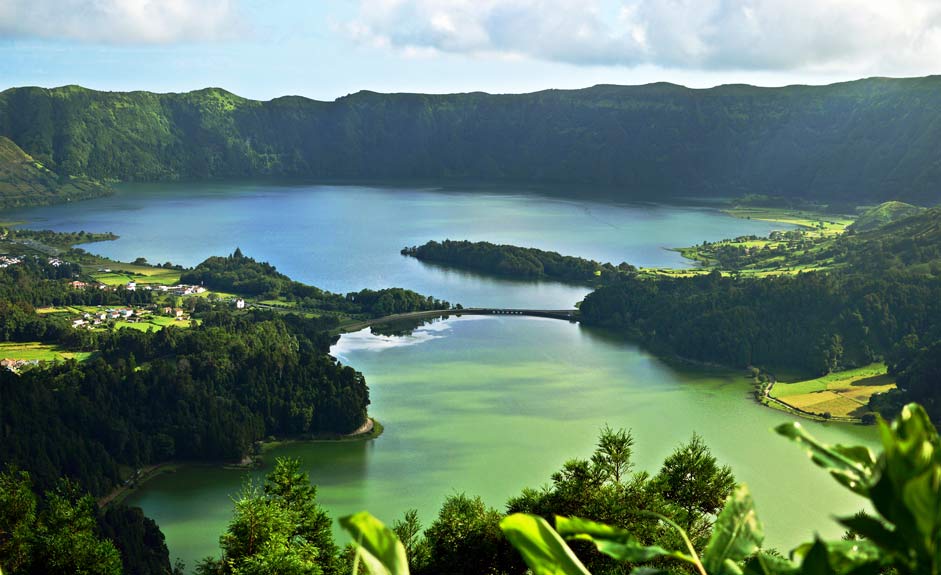
The most famous viewpoint overlooking the twin lakes is called Vista do Rei. The place is very popular, so in order to admire the gorgeous views, one might need to dodge some selfie sticks and souvenir stands. The viewpoint is a starting point for a narrow gravel road that enables doing a full circle around the crater, for example by bike or by car. For the most part, the road stays on top of the crater edge, so amazing views over the lakes and the volcanic cones surrounding them are guaranteed – on a clear day at least.
A less known but just as gorgeous viewpoint is Miradouro das Cumeeiras, from which it is possible to admire the twin lakes towards the opposite direction. The other beautiful viewpoints include Miradoudo da Candelária and Miradouro do Cerrado das Freiras, situated close to Lagoa de Santiago. From there it is also possible to visit the shores of this smaller crater lake, shining in all shades of green.
The Sete Cidades area has many hiking routes. Starting from Vista do Rei, there is a hiking trail circling clockwise around the lakes, ending in the village of Sete Cidades. Another route, equipped with even more stunning views over the volcanic crater starts near Lagoa do Canário and goes counterclockwise. Both trails are linear, so it’s mandatory to take a taxi back from the Sete Cidades village. The taxi stand is located in front of the church.
Lagoa do Canário
Another unbelievably beautiful viewpoint close to Sete Cidades is the Miradouro da Lagoa do Canário, also called Miradouro Boca do Inferno. From there it’s possible to admire the scenery opening up over the dark green craters, many small lakes and the patchwork of fields. The larger twin lakes appear on the background, while the emerald green Lagoa do Canário can be seen on the forefront. There is a skywalk trail leading to the viewpoint through the breathtaking landscape. It has a steep uphill and a downhill, but otherwise it’s easily walkable.
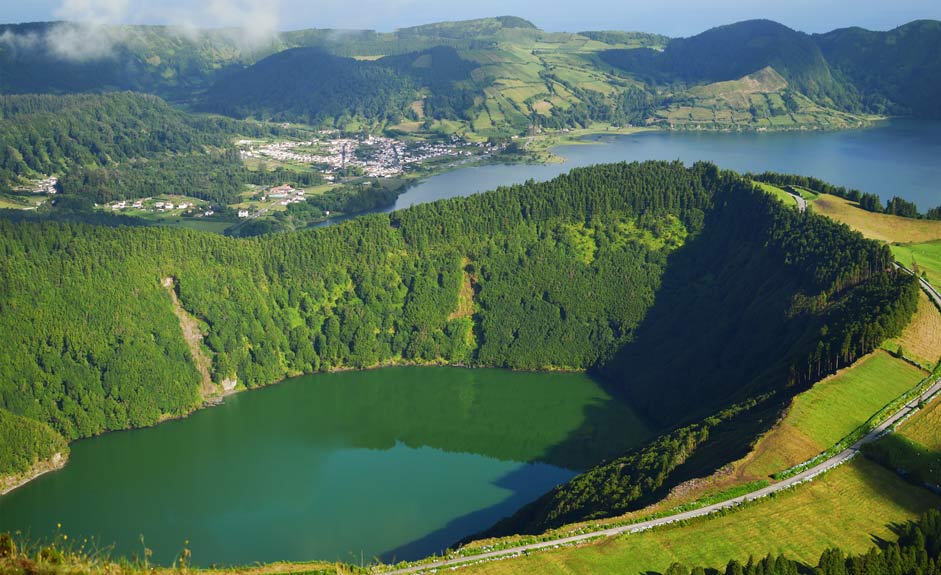
By following the dirt road towards northeast from the parking lot one gets to the close-by Miradouro do Pico do Carvão. A vast vista over the coast of São Miguel opens up from this high viewpoint.
Lagoa das Empadadas
The twin lake of Lagoa das Empadadas is also located in close proximity to Sete Cidades. The landscape over the lake surrounded by a forest of Japanese cedar is mystically calm. The lake is accessible through the Serra Devassa hiking trail, but also by car. The lake is surrounded by many trails that lead to other water bodies in the area, such as Lagoa Rasa and the ponds of Lagoa das Eguas.
Furnas
The mysterious Furnas Valley surrounded by forested slopes of volcanic origin is one of the best known towns of São Miguel. The valley is actually a crater of a dormant volcano, which has last erupted in 1630.
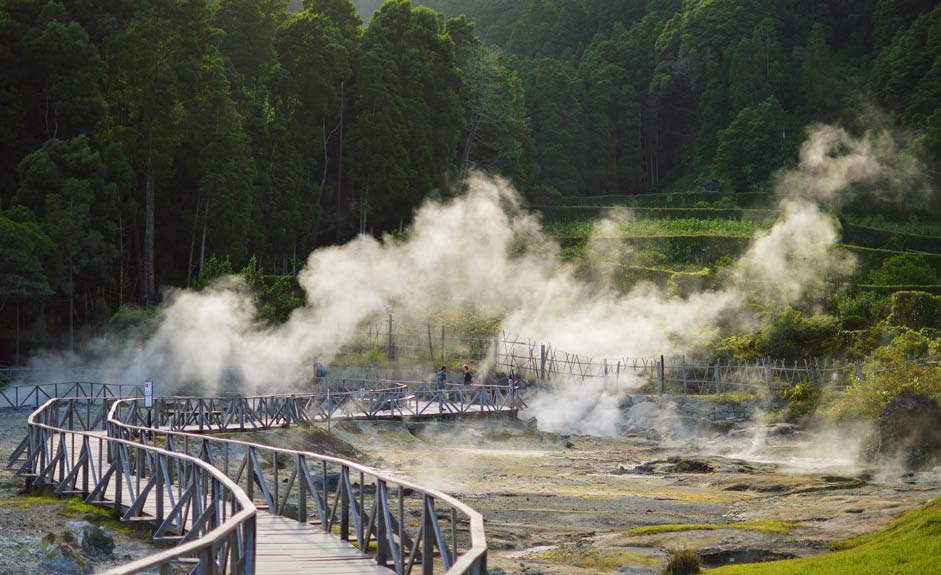
There are hot springs, geysers and fumaroles venting impressive columns of steam up to the air, located right in the center of town. Besides the volcanic activity, Furnas is known for its mineral water, flowing from the azulejo-tiled springs throughout the valley. The water is said to have a distinct taste in each of the springs thanks to the different chemical compositions.
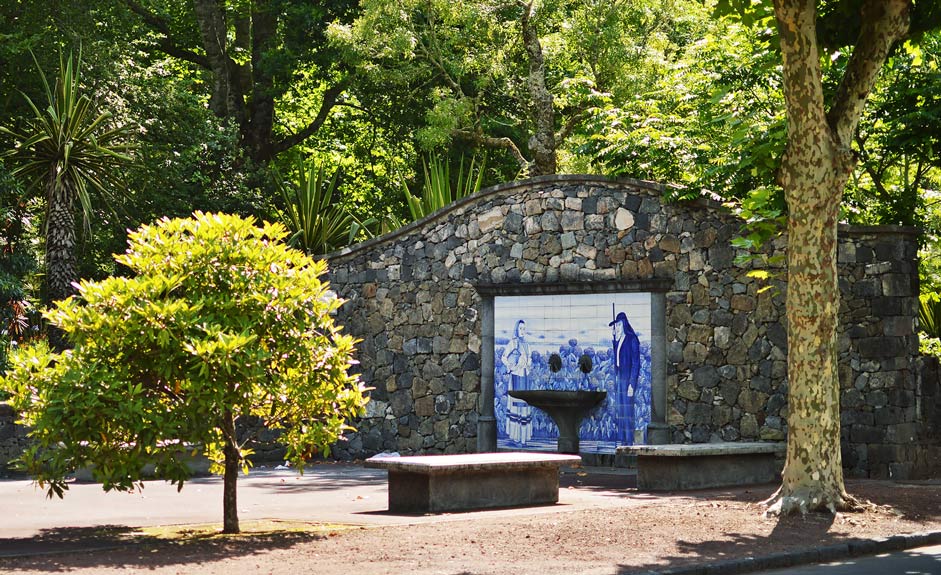
The hot springs and mineral water have made Furnas a popular holiday destination, and the town is known for its many beautiful villas. There is also an upside down house, actually an electric substation, located on Avenida Victor Manuel Rodrigues.
Lagoa das Furnas
In Furnas, the crater lake of Lagoa das Furnas is another place to witness the activity of a volcano that has been there for already 100 000 years. The lake sits at an altitude of 359 meters on the southwestern side of Furnas, a little outside the town center. The gases emitted from the bottom of the lake make it look like the water was boiling. On the lake shore there are several calderas and mud pits, bubbling with sulphuric steam. One can admire the volcanic field colored by the yellow and green mineral crystals from a close proximity, thanks to the wooden pathways and trails built in the area. The Miradouro do Pico do Ferro viewpoint is a great place to see the lake and the calderas from above.
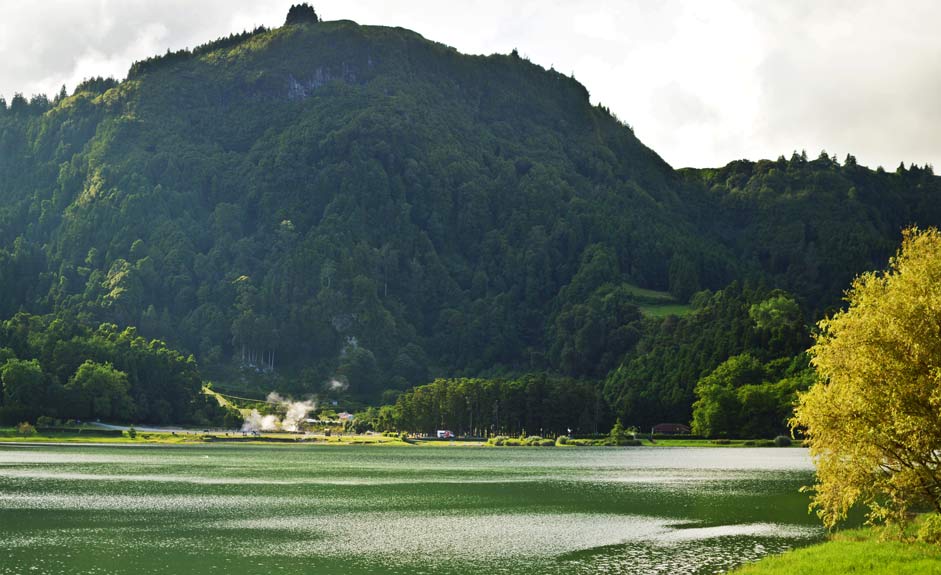
The local people of Furnas area cook a traditional stew of meat and vegetables called cozido das Furnas in potholes dug into the steaming hot earth for five hours. It’s possible to try the dish at the local restaurants, but it’s advisable to book ahead. There is also a picnic area next to the Furnas lake, equipped with barbeques.
The neo-gothic chapel of Nossa Senhora das Vitórias is a peculiar sight on the shores of the Furnas lake. A wealthy farmer and botanist José do Canto built it in the middle of the 19th century as the last resting place for himself and his wife.
Parque Terra Nostra
São Miguel is an incredibly lush island, and the best place to witness the abundance of flora is in the Terra Nostra Garden in Furnas. The 12.5 hectares of this botanical garden are filled with giant trees, colorful flowers, palm trees and other exotic plants, each one more astounding than the other.
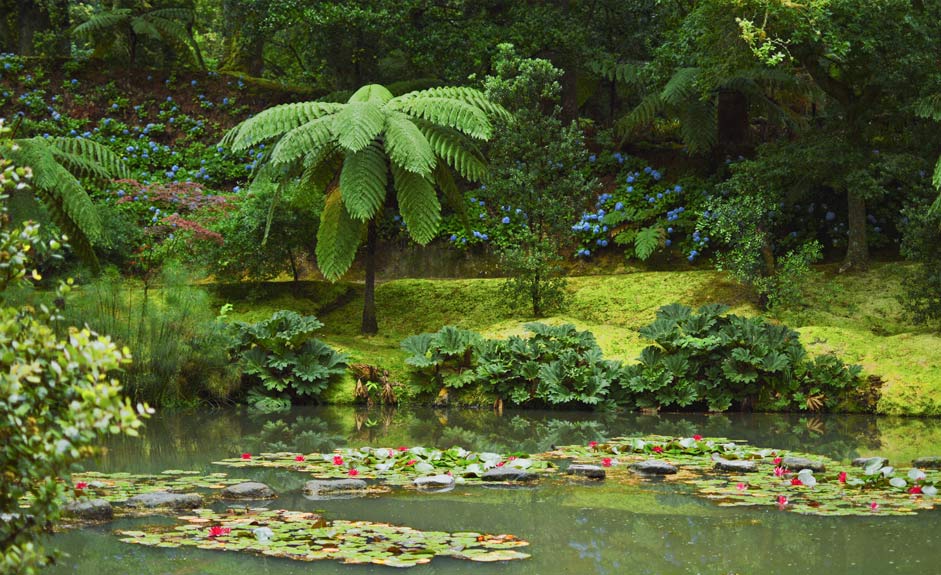
The park is a dream destination for every garden fan, including collections of azalea, camellia, bromeliad, rhododendron, fern and cycadales, as well as a collection of the endemic Azorean species. The first trees of Terra Nostra Garden have been planted around the year 1775, but most of the garden has been built during the 19th century. A warm stream, originating from hot springs, flows through the garden, and heats up the health spa also found in the park. The garden is also home to the art deco style Terra Nostra Garden Hotel with its quality restaurant.
São Miguel and especially Furnas is one of the world’s hot spring hotspots, which is why there are several of them in the town. The most famous is the large hot water pool of Terra Nostra Garden, fitting dozens of people at a time. The pool has been built already in 1780 and expanded in 1935. Since then, it has been offering relaxation and healing properties to those bathing in its 35-40 C° waters. One shouldn’t let the brownish color of the water fool oneself, since the coloration happens due to the high ferrous sulphate concentration of the water. The entrance ticket to the Terra Nostra Garden costs 8 euros.
Poça da Dona Beija
Poça da Dona Beija is a more natural outdoor spa in Furnas. The steaming hot water flows into the grotto springs from underground, mixing in the colder water and forming a lovely warm river. Floating in this yellow-brown, mineral-rich elixir is extremely relaxing and invigorating. There are five pools in the spa, surrounded by lush tropical vegetation.
The facilities at Poça da Dona Beija include showers and locker rooms with paid lockers. The pools are open until late in the evening and have an entrance fee of 6 euros. It’s worth noting that the hot spring water will likely dye the swimsuit, so it is advisable to avoid white swimsuits altogether.
Caldeira Velha
Caldeira Velha features thermal pools in the middle of the flourishing Azorean nature. The pools are heated by natural hot springs and built on a mountain slope between native trees and other vegetation, which makes the place feel like a pre-historic paradise. There are two pools in this outdoor spa, the smaller one having a temperature of 38 C° and the larger one 21 C°. There is also a waterfall flowing into the larger pool. Caldeira Velha is a popular place, so especially during the high season one might have to share the pools with other bathers, but the experience is nevertheless extraordinary.

Getting to Caldeira Velha is possible by a rental car, a taxi or as a part of an organized tour. Parking is limited. There are showers, toilets and dressing rooms. The entrance ticket costs 8 euros.
Lagoa do Fogo
Lagoa do Fogo, the Fire Lake, is a crater lake of astonishing beauty at the center of the Água de Pau volcano in the middle of São Miguel island. Água de Pau is the youngest volcano of the island, formed around 15 000 years ago and erupted last in the 16th century. The lake was formed when the top of the volcano collapsed down around 5000 years ago. Lagoa do Fogo is located in the highest altitude of all lakes on São Miguel. The whole crater is a nature reserve, where all constructions are prohibited.
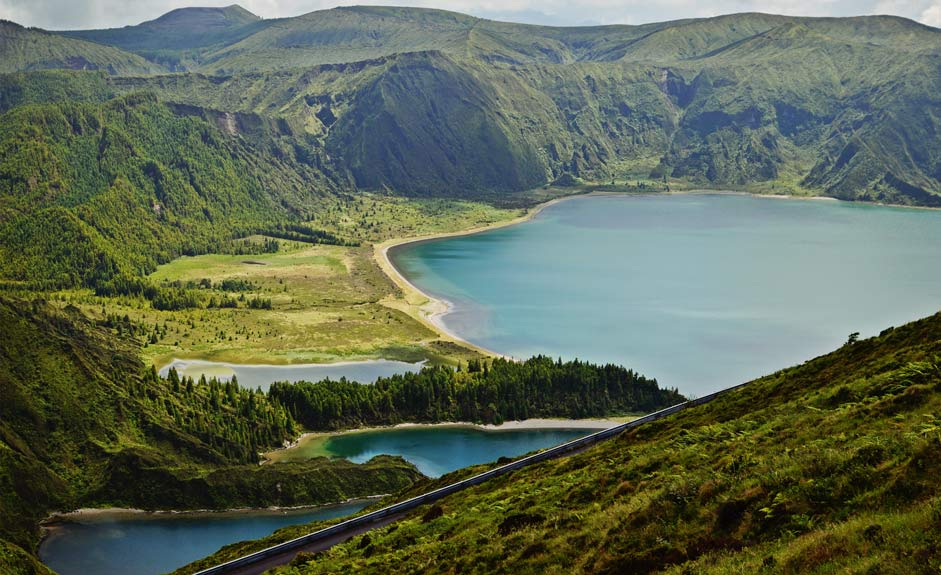
The views over the turquoise lake, surrounded by green nature and crater cliffs, are unbelievably beautiful. The gorgeous scenery can be admired from the Miradouro do Pico da Barrosa viewpoint at the altitude of 949 meters, to where it’s a short walk from the parking lot. It’s advisable to pick a clear day for visiting Lagoa do Fogo, because otherwise the views will be covered by clouds and fog. There is also a hiking trail leading down to the white sand beach cove on the lake shore.
Ponta Delgada
Over its 500-year history, Ponta Delgada has grown from a small fishing port to the largest city of the Azores. The mostly black and white volcanic rock buildings and historical cobble stone streets invite visitors to spend a day getting to know the sympathetic capital of São Miguel, where many trendy restaurants, cafés and shops have been recently opened to complement the traditional old town charm.
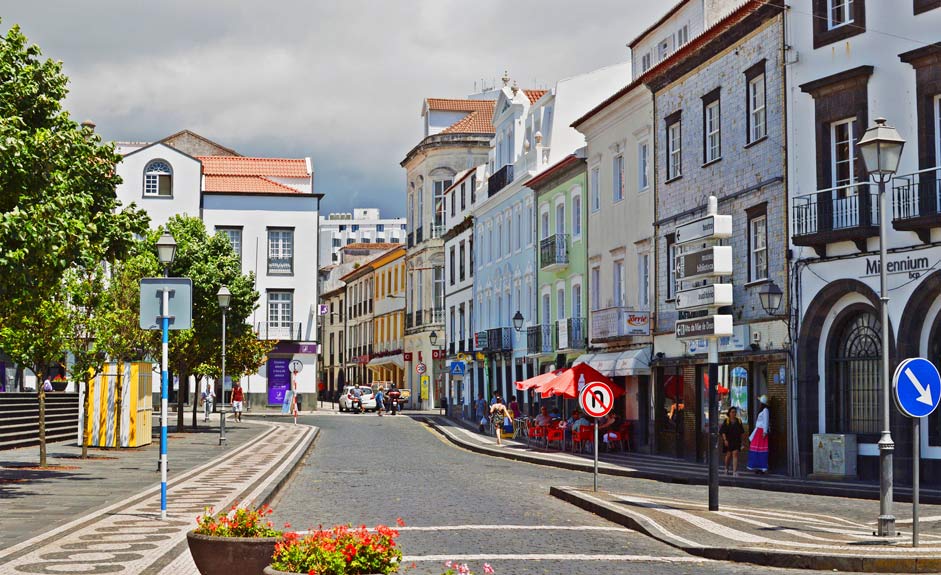
The most iconic sight of Ponta Delgada is the city gates, Portas da Cidade, also pictured in the coat-of-arms of the town. The triple arc gates were built at the end of the 18th century as a part of the defensive city wall. Nowadays they stand in the middle of the Praça de Gonçalo Velho square.
On the same square there is also the 16th century church Igreja de São Sebastião with its manueline front doors that are a great example of the building style of the era. The other doors are built in baroque style. The church was built over an older shrine, erected for the glory of the protective saint of the city, São Sebastião, after a plague that spread in the city. Another chapel worth visiting is the Igreja do Santo Cristo with its golden altar. The shrine that got its current form in the beginning of the 17th century is a part of a Franciscan monastery.
The sea fortress Forte de São Brás is a great place to visit in Ponta Delgada for those who are interested in history. The sturdy fort has been built on the eastern side of the old town in 1552 in order to protect the city against threats coming from the ocean, including pirates. A war museum is located inside the fortress.
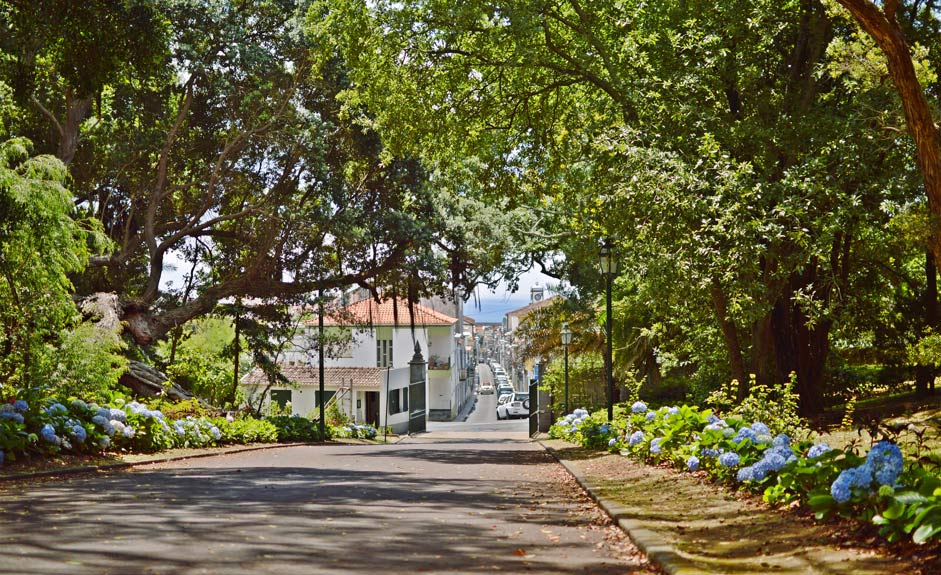
The botanical garden of Jardim José do Canto is a great place to lose oneself in the middle of the huge tropical trees and beautiful plantations. The garden was founded in the 19th century and consists of over 6000 species of flora. In addition, families with children should head to the Pinhal da Paz park, featuring a large playground, a labyrinth, a picnic area, as well as forest trails and gardens.
Pineapple plantations
São Miguel is one of the only places in Europe with pineapples are being grown. The pineapple trade started in the beginning of the 20th century, when the profitability of the orange cultivation practiced on the islands decreased. The Azorean pineapple is grown in greenhouses and produces a small, juicy and sweet fruit. When visiting the archipelago, one should definitely try this delicious fruit, either fresh or processed into a treat.
There are several pineapple plantations on the northern outskirts of Ponta Delgada, for example the Augusto Arruda Pineapple Plantation and the Ananás Santo António farm. These plantations are great places to get to know the pineapple trade and their cultivation in the sheltered greenhouses. They offer guided tours in the greenhouses, pineapple tasting and different delicacies made from the Azores pineapple, such as ice cream and liquor.
Gruta do Carvão
Gruta do Carvão is the largest cave in São Miguel, where it is possible to explore the island from underground. The lava tube was created around 5000-12000 years ago in a volcanic eruption, which is why the cave is a great place to see different types of lava rock formations. The tunnel is approximately 1900 meters in length, but during the guided tours the visitors can explore the cave on a walk of either 200 or 800 meters in distance. The entrance ticket costs 5 euros.
Observatório Vulcanológico e Geotérmico dos Açores
In this volcanologic and geothermal observatory and museum it’s possible to familiarize oneself with the enchanting geology and the volcanic activity of the Azores. There are many exhibitions in the science center that present different types of rocks, fossils and mineral examples. The science center is located in Lagoa and the ticket costs 2.50 euros.
Ilhéu de Vila Franca do Campo
São Miguel is known for its astounding natural phenomena, and the small volcanic islet off the coast of Vila Franca do Campo is one of them. From afar, the islet looks like a tiny volcano rising from the ocean, but on a closer look it’s possible to see the perfectly round pool in the middle – an ancient crater of a volcano. The pool is partially open to the sea, forming a natural swimming pool with a diameter of 150 meters and a maximum depth of 20 meters. On the southern edge of the islet there is a 32-meter high lava rock tower called Farilhão.
The islet is a natural reserve, where it is possible to observe the visiting and resident sea bird species as well as the endemic flora of the Azores. The sea water pool is an excellent spot for swimming, snorkeling and scuba diving. Some of the species spotted underwater include different fishes, starfish and rays. The islet is also one of the destinations in the annual international Red Bull Cliff Diving World Series events.
The Ilhéu is located some 500 meters away from the port of Vila Franca do Campo, from where there are ferries departing to the islet several times per day. Because of the conservation status, the visitor number is limited up to 400 daily visitors. Camping and fishing are also prohibited on the islet. Because of the limited availability, it’s advisable to book the ferry ticket ahead either from the ticket kiosk at the port or online.
Ermida de Nossa Senhora da Paz
The chapel of Ermida de Nossa Senhora da Paz is located on top of a hill on the northern side of Vila Franca do Campo. According to a legend, there was formerly a cave on the spot, from where a young shepherd had found an image of Virgin Mary. A shrine was built on the hill in the 16th century, and the current chapel was built later in 1764.
When climbing the stairs up to the chapel, one can admire the traditional azulejo tile art. From the top there are amazing views over the coast and the islet of Vila Franca do Campo.
Salto do Prego waterfall
Salto do Prego is another gorgeous waterfall located close to the village of Faial da Terra. It’s accessible only by foot along a hiking trail of 4.5 kilometers, including some steep ups and downs. However, admiring the waterfall and dipping in the crystal clear pond formed under it are well worth the hike. On the way one can get to know the village of Aldeia do Sanguinho, which was abandoned for a long time and now being recuperated. The village is named after an endemic buckthorn species growing in the area.
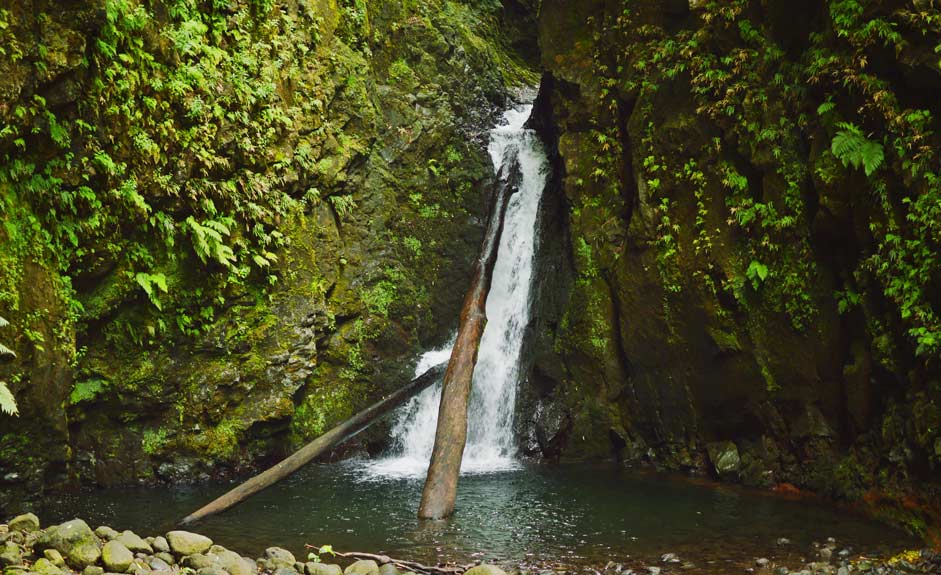
Salto do Cabrito waterfall
Waterfalls are abundant on São Miguel, and Salto do Cabrito is perhaps the best known of them. This beautiful and narrow two-part waterfall is located close to Ribeira Grande and accessible by foot on the 8.5 km long popular hiking trail called Caldeiras da Ribeira Grande - Salto do Cabrito, utilizing the hydroelectric pipes as walkways on parts of the route. It’s also possible to drive close to the waterfall by car. Under the waterfall there is a clear pond with a rock bottom, which offers welcome cooling on a hot summer day. There is also an abandoned dam close by.
Salto da Farinha waterfall
In the village of Achadinha, there is a waterfall by the sea, accessible by a 4.9 kilometers long intermediate hiking route. The trail takes the hiker to a swimming spot in the ocean via the deep blue Poço Azul pond formed under the waterfall. The best views over the waterfall can be seen by climbing up to the viewpoint situated above the waterfall. It’s also possible to drive a car close to the waterfall and have a picnic at the barbeque spot of the swimming area.
Lagoa do Congro
São Miguel is home to the most beautiful crater lakes, and Lagoa do Congro, situated a couple of kilometers outside of Vila Franca do Campo, is not an exception to this rule. The emerald green lake is surrounded by thick vegetation, which makes the place feel like a haven of peace. The lake dates back to 3900 years ago, when it was born after a volcanic explosion. The lake is accessible by a short, marked footpath.
Tea plantations
São Miguel is known for its tea cultivation, the island having the oldest tea plantations of Europe and currently also the only commercial ones. The tea cultivation on the northern side of the island started in 1878, when a local farmer’s association invited two Chinese tea specialists to teach its members about the cultivation and processing methods of tea.
The Chá Gorreana tea plantation has been cultivating tea already during five generations, starting in 1883. The tea factory is located close to the village of Porto Formoso and features a shop and a café, where it’s possible to sample the tea grown on the farm. Self-guided tours on the plantations are also allowed. The bright green tea terraces and the glistening ocean behind them form an unforgettable landscape.
Another tea producer on São Miguel is the Chá Porto Formoso tea factory, that was first working from the 1920’s until 1980’s, but reopened in 2001 in order to preserve a piece of agricultural history of the island. The organic certified black tea is grown on terrace plantations with views over the ocean. During the guided tours the visitor gets to know the production process of tea and taste the end result. An annual traditional harvest festival is organized on the first Saturday of May.
Nordeste
There are many precious coastal villages on São Miguel, but perhaps the most picturesque is the remote Nordeste. The village is located on the northeastern corner of São Miguel, and it is the center of the least inhabited municipality on the island. The black and white lava rock houses and churches highlight the calm atmosphere. There is also a botanical garden featuring waterfalls called Ribeira do Guilherme.
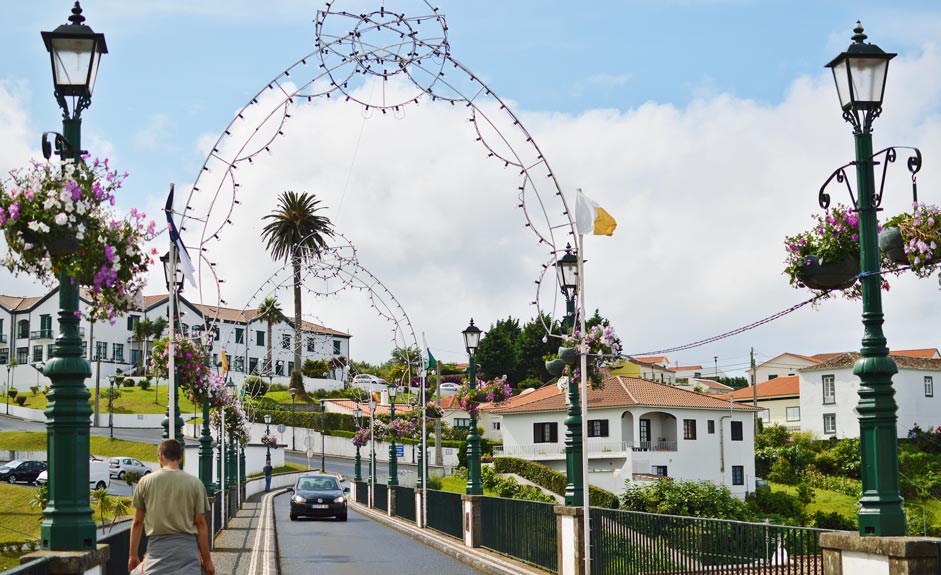
The Arnel lighthouse, located next to the village of Nordeste, is overlooking the coast above a high cape. It was the first lighthouse that was built in the Azores, functioning since the year 1876. There are some houses and a small port next to the lighthouse. The best photos of the lighthouse can be taken from the Vista dos Barcos viewpoint.
Ponta do Sossego viewpoint
The viewpoint on the eastern end of São Miguel offers some gorgeous vistas above the green cliffs of the coast. There is a dirt trail lined by hydrangeas, and when they are blooming in the summer it really feels like a paradise. Hence, Ponta do Sossego is a great place for a picnic.
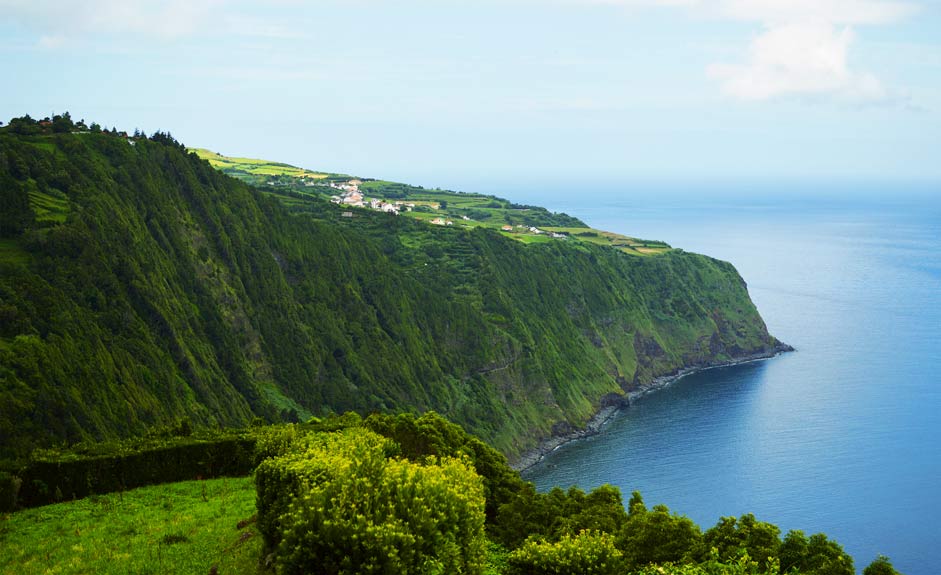
Pico da Vara
The highest point of São Miguel, Pico da Vara, reaches an altitude of 1105 meters above sea level. Because the peak is surrounded by a forest conservation area, a permit is needed from the regional forest secretary (Secretaria Regional dos Recursos Florestais) in order to access the hiking trail leading to the peak. The conservation area was founded in order to protect an endangered bird species found only on São Miguel, the Azores bullfinch.
Parque Natural da Ribeira dos Caldeirões
The Natural Park of Ribeira dos Caldeirões is a nature conservation area by a stream of the same name. In the park there are five watermills dating back to the 16th century, nowadays hosting a café, a souvenir shop and an ethnographic museum. There are walking paths and both endemic and exotic plants to be observed. However, the main attractions are the waterfalls, creating an incredibly beautiful contrast between the green valley and the watermills built of stones. It’s also possible to do canyoning in the waterfalls. The park is located close to the village of Achada.
Whale watching safaris
The Azores are a world-class destination for watching whales and dolphins in their natural habitat, and therefore a whale watching tour is one of the most unforgettable experiences to be had when visiting São Miguel. It’s possible to see the largest sea mammal of the world, to swim with wild dolphins or dive with sharks. Several dolphin species are resident in the Azorean waters staying there around the year, whereas many whales cross the archipelago when moving up to the Northern Atlantic for the summer. The whale watching tours are usually organized from April until October, but the best time for spotting the largest whale species is in the spring from April to May. Dolphins and sperm whales can be seen throughout the year.
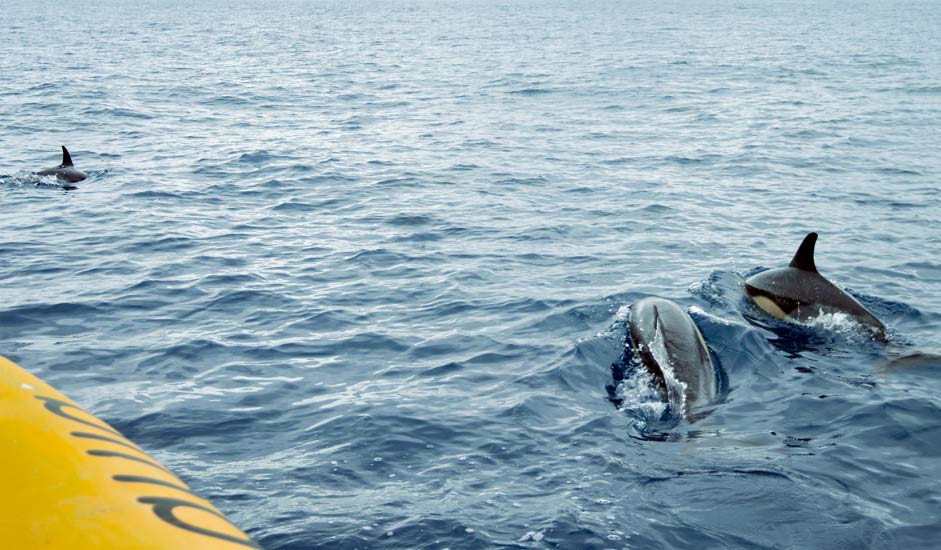
The whale safaris in the Azores are ethically organized. The tour guides do not go too close to the animals or harass them. Swimming with dolphins is based on the natural curiosity of these intelligent sea mammals, and respects the dolphins’ boundaries.
Activities
Getting to know São Miguel from below the surface is amazing, so it is highly advisable to include a water-based activity in the holiday agenda. There are several surf schools and companies offering scuba diving and snorkeling tours, as well as kite surfing and sailing. A paddling trip to explore the coast of the island is an amazing experience, whether it was carried out on a kayak or a SUP board. It’s also possible to practice fishing and spear fishing, as well as extreme sports such as paragliding, coasteering, rock climbing or canyoning.
There are jeep tours and bike trips available for exploring São Miguel by land. Also hiking is a very popular activity on the island and there are many well marked hiking trails for every taste, in variable sceneries.
When on the sea and in the coastal areas, it’s advisable to watch out for strong waves and sea currents, as well as the stinging Portuguese man o’wars. These invertebrates floating on the water have stinging tentacles and they can be seen on the shores of the Azores especially in spring and early summer, sometimes in vast swarms.
São Miguel is also a beach destination with its black sand beaches and natural pools
Ponta da Ferraria
The thermal sea water pools of Ponta da Ferraria are a unique experience, because there is no other easily accessible place in the world where it would be possible to bathe in a hot spring located in the ocean. The hot water flows from between the volcanic rocks, mixing with the cool Atlantic waves and forming a warm pool where to take a dip. The Ponta da Ferraria pools have been a place of healing and relaxation since the settlement of the island, and the mineral-rich water is said to cure many ails, such as joint pains.
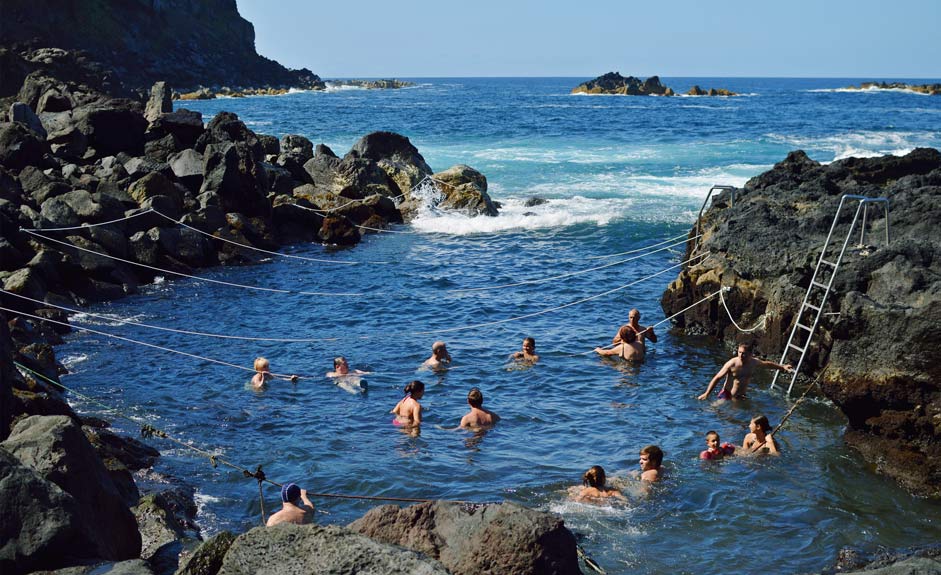
During high tide the water of the Ferraria natural pools is not very warm and the waves can crash into it, so the best time for a dip is during low tide, when the sea is reasonably calm. The feet may not reach the bottom of the pool, but ropes have been installed there and can be grabbed in case of waves crashing in. Ponta da Ferraria is located in the western end of São Miguel, so the place is also great for watching the sunset. The natural outdoor pool is free of charge, but in Ferraria there is also a paid health spa, offering treatments with the same thermal sea water. Ponta da Ferraria is best accessed by a rental vehicle or taxi.
Praia de Santa Bárbara
Santa Bárbara is one of the lengthiest beaches of São Miguel, where the soft sand and beautiful views stretch over a kilometer of length. The dark sand beach is located next to Ribeira Grande and has all the facilities from beach bars and restaurants to toilets, showers and beach guards. The beach is popular among surfers and bodyboarders, and there is also a surf school renting out the equipment.
Mosteiros
The distinct lava rock statues molded by erosion and rising from the sea are one of the best known land marks of São Miguel, and can be admired from the Mosteiros beach. The beach is popular with swimmers and surfers alike, and a gorgeous spot for sunset watching.
Praia dos Moinhos
Praia dos Moinhos is one of the most beautiful beaches of São Miguel. The light sand beach is located in the village of Moinhos, close to Porto Formoso. The facilities include a restaurant, showers and toilets.
Praia de São Roque
São Roque is an urban beach and the closest to Ponta Delgada. There is a church overlooking the beach from top of a cliff. The small black sand beach is nice for swimming and sunbathing. It can be accessed from Ponta Delgada by foot in around 45 minutes and in 10 minutes by car.
Praia das Milicias & Praia do Pópulo
Praia das Milicias is a sandy beach close to Ponta Delgada, popular among sunbathers and sufers. The beach has great facilities from a playground to several beach bars, restaurants and accommodation. The next smaller beach, Praia do Pópulo, is a short walk away on the other side of the cape.
Praia do Lombo Gordo
The beach of Lombo Gordo is surrounded by natural beauty and hidden under the green coastal cliffs. The perfect cove is a good choice for spending a beach day on the eastern side of São Miguel. There is a steep but drivable switchback road going down to the beach.
Praia da Viola
Praia da Viola is located on the northern coast of São Miguel, close to the village of Maia. The untouched beach is the destination of a hiking trail, along which it’s possible to admire old water mills, traditional washbasins and a stream forming a waterfall.
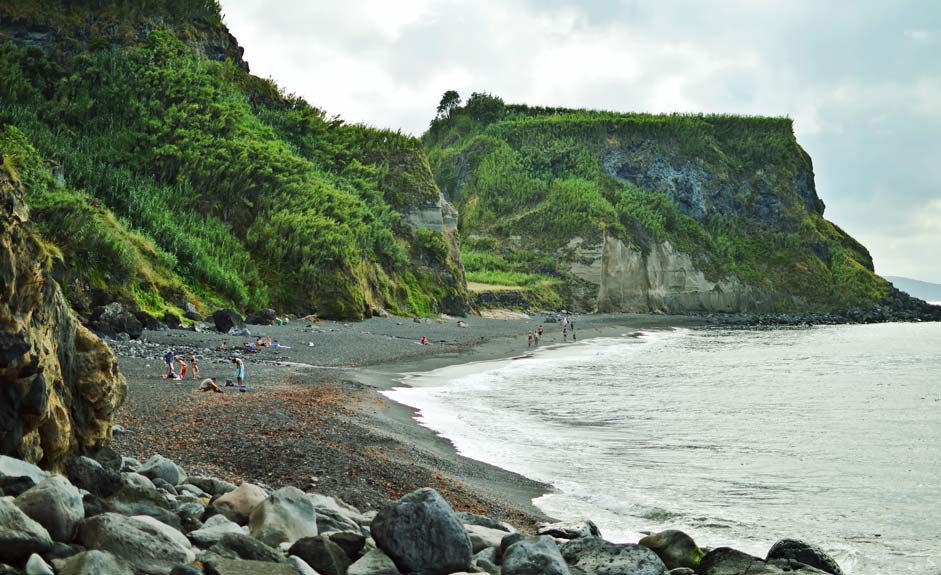
Praia do Fogo
When going from Furnas towards the village of Ribeira Quente, there is a warm-water waterfall of the same name. By the sea, one can find a gorgeous beach of turquoise waters surrounded by green hills, called Praia do Fogo.
Piscinas do Pesqueiro
The pool complex of Piscinas do Pesqueiro is located in the port of Ponta Delgada and offers cooling moments in the center of the city. The pool area has a large sea water pool as well as conventional pools.
Complexo Municipal de Piscinas – Lagoa
This pool complex is built among lava rocks and located in the village of Lagoa, east from Ponta Delgada. The complex consists of natural sea water pools as well as conventional swimming pools. It’s a good destination for a beach day especially for families with kids.
Zona Balnear do Frade
The natural pools formed in a rock-bottomed shallow coastal cove are a great place for swimming and snorkeling in the village of Maia. There is not much of flat terrain, so the beach towels have to be spread on top of the sun-warmed lava rocks.
Piscina Natural da Boca de Ribeira – Nordeste
The Boca de Ribeira natural pools are located in Nordeste, in a valley below lush slopes, where a stream meets the ocean. Swimmers can choose between a pool filled with sea water and the ocean.
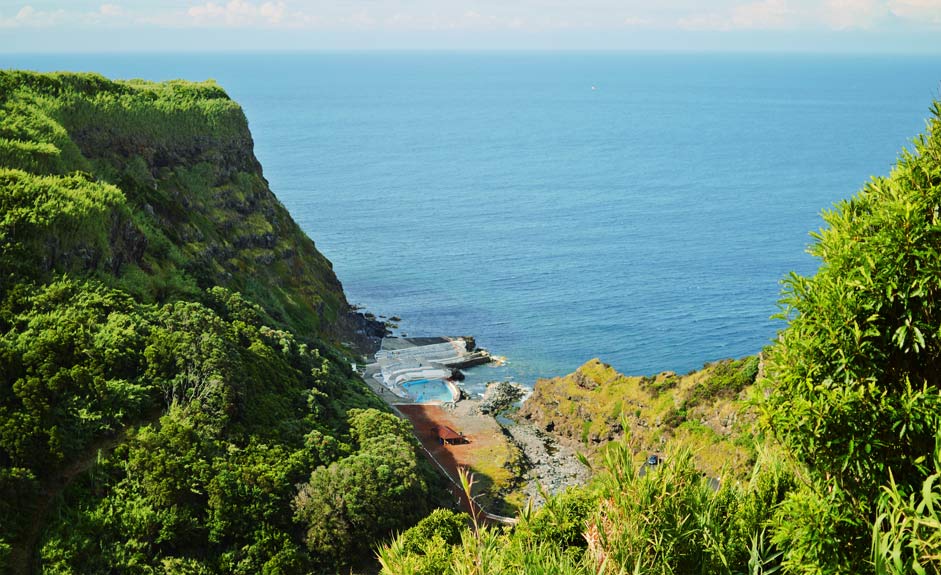
Exotic flavors and food prepared in a volcano – what to eat on São Miguel
The most famous dish from São Miguel is the stew cozido das Furnas, combining meat and vegetables into a hearty dish that is cooked in a steaming pothole dug in the hot soil of the volcanic caldera of Furnas. The Azores are also known for their beef of excellent quality, which is why meat lovers should try for example the bife à regional steak, served with a fried egg and vegetables. The fresh cheese queijo fresco, served with home-made hot sauce, is a mouthwatering starter. Bolo lêvedo, on the other hand, is a slightly sweet wheat bread baked on a pan and invented in Furnas as well. The bread is best enjoyed with jam or cheese, or even as a hamburger.

São Miguel also has a variety of fresh ocean fish and seafood. Especially the limpets, grilled with butter and garlic, are utterly delicious. The tuna steaks caught on the Azorean waters are worth trying as well.
From the dessert selection, the queijadas de Vila Franca do Campo cupcakes are simple but very appetizing – the oven fresh ones can be found at the port of Vila Franca. The sweet pineapples grown on São Miguel are a great dessert when eaten fresh, but they are utilized in many dessert dishes as well. Pineapples can be bought directly from the farms or from the grocery stores of the island.
There are some great Azorean wines to accompany any meal, the commercial production being centered mostly on the island of Pico. São Miguel, on the other hand, has production of a local beverage called Kima, available in passion fruit or pineapple flavor. The island is also home to the only commercial tea plantations of Europe, whose yield can be sampled on the farms or brought back home as a souvenir.
Shopping on São Miguel
Even though the archipelago of the Azores or the island of São Miguel is not exactly known for its shopping opportunities, the island has still a nice selection of stores for making souvenir finds or stocking on the daily essentials. The shopping is centered in the capital Ponta Delgada, but other towns are also equipped with supermarkets, minimarkets, pharmacies and other shops.
The Parque Atlântico shopping mall, located in Ponta Delgada, is the largest mall of the Azores. It has over 100 chain stores and boutiques, a large supermarket, a cinema and a food court. There is also a smaller shopping mall called Sol Mar Avenida, located on the Avenida avenue. The old town of Ponta Delgada has also several shops for making local finds. The busiest shopping streets are Rua dos Mercadores and Rua de São João.
Ponta Delgada also has a market called Mercado da Graça, that has a good selection of fresh fruit and vegetables, meat and fish, canned foods and – of course – pineapples. Also the Louvre Michaelense boutique and café, founded in 1904, is a sight of its own. Back in the days, the shelves were filled with hats imported from Paris, but today they hold local artisanal products and different delicacies.
From airport to the city center and moving around on São Miguel
The João Paulo II airport is located right next to Ponta Delgada. Because it’s a short trip, a taxi to the city is affordable. Also the ANC Aerobus shuttle bus operates from the airport to the city center every 40 minutes, making several stops around the city.
On São Miguel, it’s possible to explore a good part of the island with public transport, even though the bus lines do not cover every part of the island. One might have to change the buses, and the linking connections aren’t always the smoothest. For example, it’s possible to travel from Ponta Delgada to Furnas and Nordeste by public transport.
The tourist bus company Yellow Bus operates two hop on, hop off tours on the island, starting from Ponta Delgada and covering some of São Miguel’s main sights. One tour line covers the western part of the island including Sete Cidades, and the other drives to the center of the island to the Lagoa do Fogo viewpoint. The tours depart in front of the Forte de São Brás.
The most useful mean of transport on São Miguel is a rental car, which enables exploring the more remote nature spots without a tight schedule. There are car rentals at the airport and in the center of Ponta Delgada. It’s worth noting that many rental agencies forbid driving on dirt roads.
Weather and climate
The climate of the Azores is maritime subtropical, including mild winters and warm summers, which is why São Miguel is a great year-round travel destination. The difference between the mean temperatures of the coldest and warmest months is only 8 °C. The weather can change rapidly though, and when on the Azores, it’s possible to experience all four seasons in one day, be it winter or summer. Hence, it’s advisable to plan the holiday according to the weather forecast and remember that visiting the higher viewpoints is worth it only on a clear day.
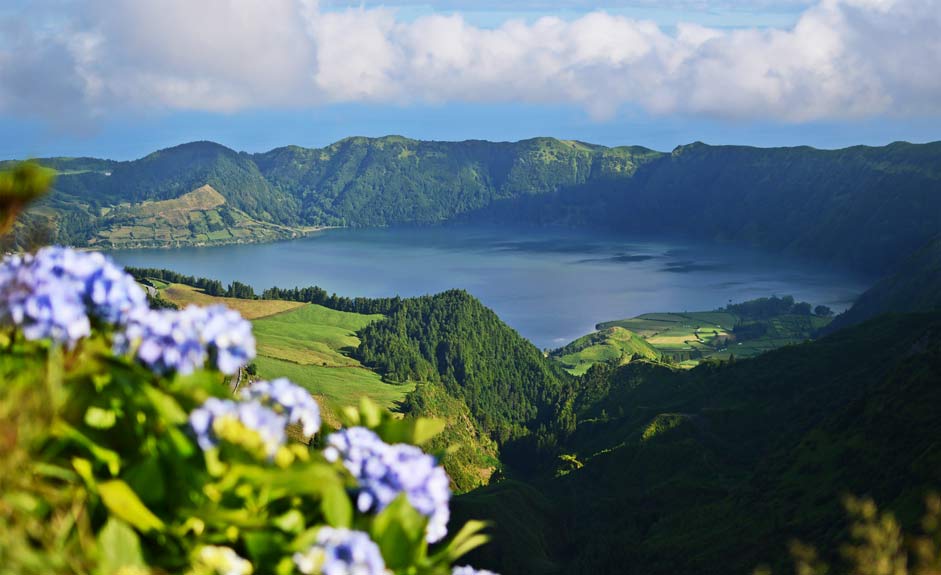
The sea temperatures of São Miguel are warmer than continental Portugal, thanks to the Gulf Stream passing by the Azores. The temperature of the sea water is 16 °C in winter and 24-25 °C in summer.
Winter: The daytime temperatures are usually from 15 to 18 °C and nighttime temperatures between 12 and 16 °C. It’s rainy from October to March and storms bringing high winds with them are common.
Spring: The maritime climate has a delayed effect on the temperatures, and the air temperatures rise slowly in springtime. A clear difference can be noted as late as May, but the rains start to diminish starting from April.
Summer: The daily mean temperatures rise above 20 degrees in July. The daytime temperatures from July to August are between 23 and 26 degrees and nighttime temperatures between 19 and 20 °C.
Autumn: Temperature-wise, September is still a summer month, being normally warmer than June. In October, the mean temperatures drop below 20 degrees. Tropical storms and even hurricanes are common during autumns, but their strength has usually already diminished when they reach the Azores.
---
Text and photos: Johanna Maldonado



